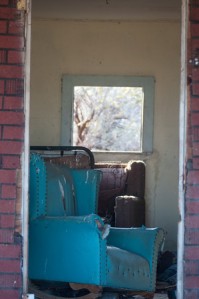In downtown White Sulphur Springs, most storefronts are empty. The short buildings hunch over their dusty windows, making themselves as small as possible as if apologizing for their sorry state. Weeds grow alongside the streets and at buildings’ edges. In the closed taxidermist shop, frozen raccoon and deer stare out with blank eyes at the cracked and crumbling sidewalk.
At one end of the block is an abandoned western wear store, once located in the lower story of a red stone building.
In the window, a small sign defends it, declaring it part of the National Register of Historic Places. Built by Dr. William Parberry in 1891, the Parberry block was part of White Sulphur Spring’s first growth spurt, fueled by speculation, deep hope, and little else. In the architectural design, Parberry wanted to copy European architecture from the 16th century, including stone arches with elaborate carvings. Glass windows were carried across the country by carriage, an impressive luxury in 1880s Montana. Parberry wanted to give his building Europe’s sense of permanence as he built up the town of his speculation on the plains under the mountains.
Despite his architectural choices, White Sulphur Springs is still fighting the struggle for permanence, as are many small rural Montana towns. Many are stuck in the bust portion of boom and bust economy, whether it be timber, mining, or gas development. Run dry, they now struggle to create reasons for their young populations to stay. In White Sulphur Springs’ homecoming parade, each high school class could barely fill a truck bed.
Just outside of the struggling town, the old mountains loom, mockingly permanent above the prairies. Below the mountains, life is built to move, to adapt to constant change. The hoofed animals move to follow water and grass, once followed by wolves and bears, now stalked by hunters and crowded by development. Even clouds don’t stay long here, hurried on by strong winds till they snag on the mountains. Recognizing the nomadic nature of the prairies, conservation efforts are increasingly focused on restoring migration corridors and connecting large tracts of land.
Still, towns like White Sulphur Springs try to push their roots deeper into the dry soil. A copper mining company speculating 16 miles north of town has been welcomed for its prospect of jobs, infrastructure investment, and people coming back into the town. But the mine’s expected lifetime is only 20 years, and despite the company’s honest efforts to invest in the community, the copper is a finite resource. Perhaps this project is just prolonging the inevitable death of the town, only pushing back the day when White Sulphur Springs joins the crumbling ghost towns across Montana.
But maybe not. Many people here love the town deeply, and are investing in its future, both through copper and other ventures. White Sulphur Springs is home to the growing Red Ants Pants company and music festival, and increasing tourist opportunities through hot springs and the nearby federal lands. The prairie has always demanded creativity, flexibility, and hard work from those who make it their home, and White Sulphur Springs has plenty of that. After all, Parberry’s building may be empty, but it still stands strong, ready to serve the town as it moves into its future life on the prairie.
